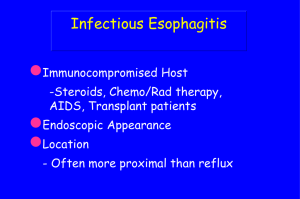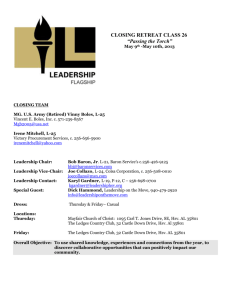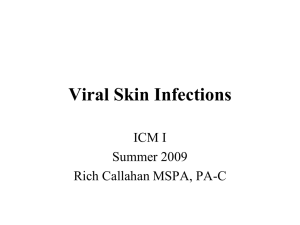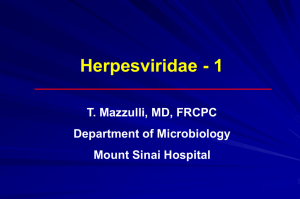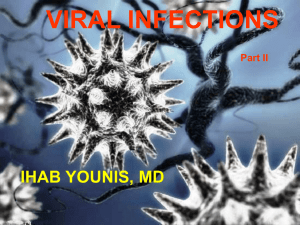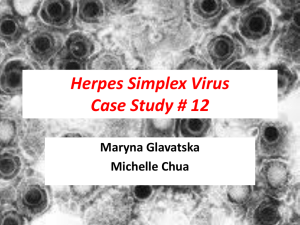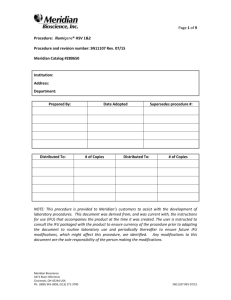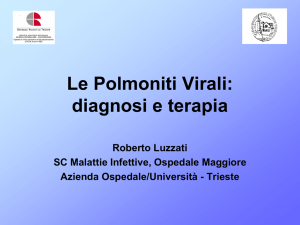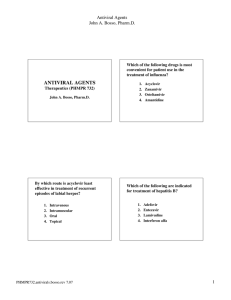lec4
advertisement
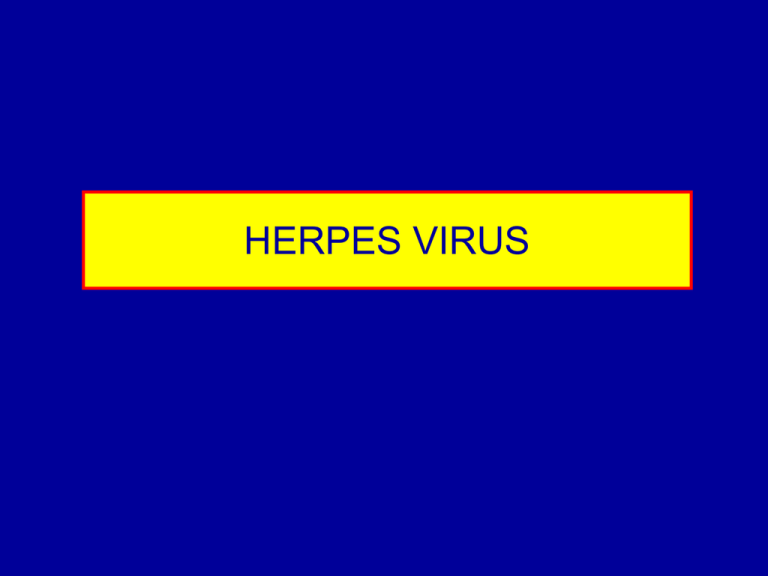
HERPES VIRUS Herpesviruses Sub -fa mil y Gro w th Cyc le La t e nt In f e ctio n s Ge n us Sys te mat i c Nam e Com mon Nam e A lp haherpesv irus Sh ort Neur on s Si m pl exvir us Si m pl exvir us Va r ice ll ov irus HHV-1 HHV-2 HHV-3 H SV-1 H SV-2 VZ V Be t a her pe sv irus Lo n g Gla nd s , k id ney , Ma c roph ages Cy t om e gal ov irus R os e olo vir us R os e olo vir us HHV-5 HHV-6 HHV-7 HCM V HHV-6 HHV-7 Gam ma herpesv irus Va r ia bl e Lym phoid t is s ue Lym pho cr y pt ov ir us R ha dino vir us HHV-4 HHV-8 EBV K SH V Herpesvirus Architecture envelope tegument capsid DNA L. Henderson, NCI g a b Herpesvirus infections are common… HSV1 HSV2 VZV EBV CMV HHV6 HHV7 HHV8 healthy children 20-40% 0-5% 50-75% 10-30% 10-30% 80-100% 40-80% <3% healthy adults 50-70% 20-50% 85-95% 80-95% 40-70% 60-100% 60-100% 5-10% adapted from Straus SE in Principles and Practice of Infectious Diseases, 2005 Herpesviruses • Large, double stranded DNA viruses • Transmission by close contact – exception - VZV (aerosol) • Latent (quiescent) and lytic (replicative) cycles • Specific tissue tropism HSV Infections HSV1 Mucosal – Gingivostomatitis – Pharyngitis – Genital (10-15%) Eye – Keratitis – Blepharitis/conjunctivitis Skin – Painful vesicles – erythema multiforme CNS – encephalitis – Bells palsy HSV2 Mucosal – Gingivostomatitis – Pharyngitis – Genital Skin – Painful vesicles – erythema multiforme CNS – meningitis – Bells palsy *Other (usually immune compromised): tracheobronchitis, pneumonia, epiglottitis, esophagitis, colitis, hepatitis, retinitis Herpes simplex - Primary Infection • Infection by direct contact and viral entry via mucous membranes or keratinized layer of skin • Incubation period 2-8 days • Systemic symptoms may occur (fever, malaise, myalgias) • Skin/systemic symptoms resolve within one week, although cervical LN enlargement may take longer *** many infections are asymptomatic Primary Oral-Facial HSV Fever Malaise Myalgias Difficulty eating Cervical adenopathy Exudative or ulcerative pharyngitis Palate, tongue, buccal mucosa or gingiva may be involved Duration 3-14 days Herpes gladiatorum Whitlow Genital Herpes Infections •Transmission via the genital mucosa •Latency in sacral ganglia •85-90% HSV-2 • transmission to discordant partners: • 50-75% of genital HSV acquired from an asymptomatic partner • mean of about 4 months • rate of about 10% per year • easier for women to acquire from men Genital Herpes: Clinical Features Primary disease: • systemic symptoms (70%) Recurrences: • duration of lesions about 10 days • pain (98%) • lesions more often unilateral • dysuria (63%) • 25% completely asymptomatic • tender adenopathy (80%) • 50% who have symptoms have prodrome of tingling/pain • duration of lesions: 2-3 weeks • Lesions more often bilateral • HSV isolated from urethra/cervix in 80+% of patients Genital Herpes: Other Features • HSV-1 less often symptomatic • meningitis in up to 8% (usually HSV-2) • distant skin lesions (20%) • bladder dysfunction (2%) • proctitis (usually MSM) • higher rates of meningitis and urinary retention in women • women more often culture positive Genital HSV Burden of disease: – in the US ~ 45 million infected – No correlation with race, geography, education, marital or socioeconomic status Viral “shedding” – occurs intermittently – more virus shed with active/symptomatic lesions or with immune suppression (may increase HIV acquisition) – shedding occurs on 1-8% of days with no lesions by culture (up to 28% of days by PCR) – Reduced with antivirals (to about 3% of days by PCR) Genital HSV • 88-92% of seropositive people do not recognize that they are infected • Primary/secondary prevention with antiviral medication is effective (later) • HSV2 disease increases HIV acquisition risk approx 3-fold HSV Diagnosis • Clinical clues (pain, same site of past recurrence) • Tzanck prep – ~65% sensitivity and specificity – Multinucleated giant cells with intranuclear inclusions HSV Diagnosis • Culture (fresh ulcer or vesicle) – 25-50% sensitivity overall, 90% if done within 48h – 100% specificity – Takes 24-48h to achieve cytopathic effect in culture • Immunofluorescence – Helpful for tissue specimens HSV Diagnosis • Serology – Sensitivity and specificity >90% • IgM not useful – does not distinguish between acute infection and recurrence • IgG conversion may take 6 months • PCR (CSF) – >95% sensitivity and specificity Herpes simplex - establishment of latency Following primary infection: 1) local replication in dermis/epidermis (responsible for symptoms of primary infection) 2) entry into neurons (sensory or autonomic) • intra-axonal transport to nerve cell bodies in ganglia • neural replication • centrifugal migration via sensory nerves • latency Herpes simplex - risk factors for reactivation (oral/genital lesions) • • • • • Sunlight Fever Menstruation Stress Trauma (multiple recurrences/severe disease) • HIV • chemotherapy • Transplant (70%) • Skin disease • Burns • Steroids • Pregnancy Neurologic Disease and HSV • encephalitis (HSV1) • Mollaret’s syndrome • meningitis (HSV2) • Bell’s palsy • Autonomic dysfunction HSV Encephalitis • Primary infection with entry via olfactory tract • Extension from trigeminal or other cranial nerve ganglia via nerves passing through middle cranial fossa • Most cases thought to represent reactivation of virus from sites of latency in the CNS • HSV PCR in CSF: – sensitivity 98% (false neg if <4 days from sx onset) Cytomegalovirus (CMV) • Majority of population infected by age 40 (>75%) • Viral shedding from respiratory and urinary tract • Routes of transmission: sexual, close contacts, transfusion, organ transplant, perinatal Cytomegalovirus (CMV) Cell targets of infection: – hematopoietic cells (mononucleosis) – Intestinal epithelium (esophagitis/colitis) – endothelial cells (organ transplant rejection) – Renal epithelial cells (renal failure) – Salivary gland epithelium (parotitis) – Cardiac myocytes (heart failure) – Hepatocytes (hepatitis) – Dorsal root ganglia (polyradiculopathy) CMV mononucleosis • fever • pharyngitis, rash, lymphadenopathy and splenomegaly less common than with EBV • Heterophile antibody negative • Hepatitis (granulomatous), hemolytic anemia, thrombocytopenia more often than EBV CMV Disease in Immunocompromised AIDS – – – – – – – Retinitis Colitis Esophagitis Cholangitis Polyradiculopathy Pneumonia Meningoencephalitis (less severe vs HSV) Organ transplant – Pneumonia – Hepatitis – Fever – myocarditis – GVHD ***Disease usually occurs in transplanted organs Normal CMV Retinitis CMV: Diagnosis • Culture – tissue, urine • Antibody testing – Risk assessment prior to organ transplantation • qPCR for CMV DNA (>1000 copies/ml = CMV disease in immune compromised) • Pathology-intranuclear inclusions CMV Intranuclear Inclusions Owl’s eye cell HHV-6 (roseola) • Probable transmission through saliva • Infects T cells and manipulates cytokine signaling • Clinical Features – Fever + rash (“sixth disease” or roseola infantum, often biphasic illness - fever precedes the onset of the rash; at the time the rash appears the child is afebrile) – Febrile seizures – Mononucleosis – Rare – encephalitis, hepatitis, myocarditis • Infections during immune suppression – HIV – Organ transplantation – Multiple sclerosis HHV-7 • Probable transmission through saliva, cervical secretions and breast milk • >95% of adults are seropositive • Replicates in CD4+ T cells and manipulates cytokine signaling • Clinical Features – Fever + rash (exanthem subitum) – Febrile seizures – Mononucleosis – Rare – neurologic disease, hepatitis, myocarditis • Immunosuppression – Organ transplantation (marrow suppression) Herpesvirus Infections: antiviral tx Acyclovir/famciclovir – converted by herpesvirus thymidine kinase to monophosphate – converted by cellular enzymes to dGTP analog which inhibits viral DNA polymerase – Useful for HSV, VZV infections Ganciclovir – converted by CMV phosphotransferase to monophosphate – converted by cellular enzymes to triphosphate – Competitively inhibits dGTP incorporation and viral DNAp Cidofovir – dCTP, converted by cellular enzymes to active triphosphate which inhibits DNA polymerase - thymidine kinase independent Foscarnet – competitive inhibitor of DNA polymerase Herpesvirus Infections: antiviral tx Valyl (valine) esters: • Prodrugs of acyclovir and ganciclovir – Valacyclovir – Valganciclovir • Confer approx 50% greater bioavailability • Converted to active drug after rapid first-pass metabolism in intestine/liver • Allow for longer dosing interval HSV: Utility of antivirals Acyclovir or Valacyclovir • Reduces pain, decreases viral shedding and speed healing of primary genital HSV • Effectively suppresses recurrent HSV (up to 80% reduction in recurrences) • Reduces, but does not eliminate, asymptomatic HSV shedding – Reduces transmission horizontally and vertically • Improves morbidity and mortality outcomes in HSV encephalitis • Prevents HSV infection in patients receiving chemotx or organ transplants (from about 70% to 5% of patients) • May reduce HIV transmission CMV: Utility of antivirals Ganciclovir or Valganciclovir • Effective for reducing replication and controlling progression of CMV disease during immune suppression (transplant, HIV) • No clear data for improved outcomes in immune competent patients • Effective for prevention of CMV disease in highrisk transplant recipients (D+/R-) or (D+/R+) HHV6/7: Utility of antivirals • IC50 for acyclovir or ganciclovir too high • Cidofovir reasonable if convincing clinical disease and withdrawal of immune suppression is not feasible Chickenpox, Varicella Zoster HSV-1 Cold sore
